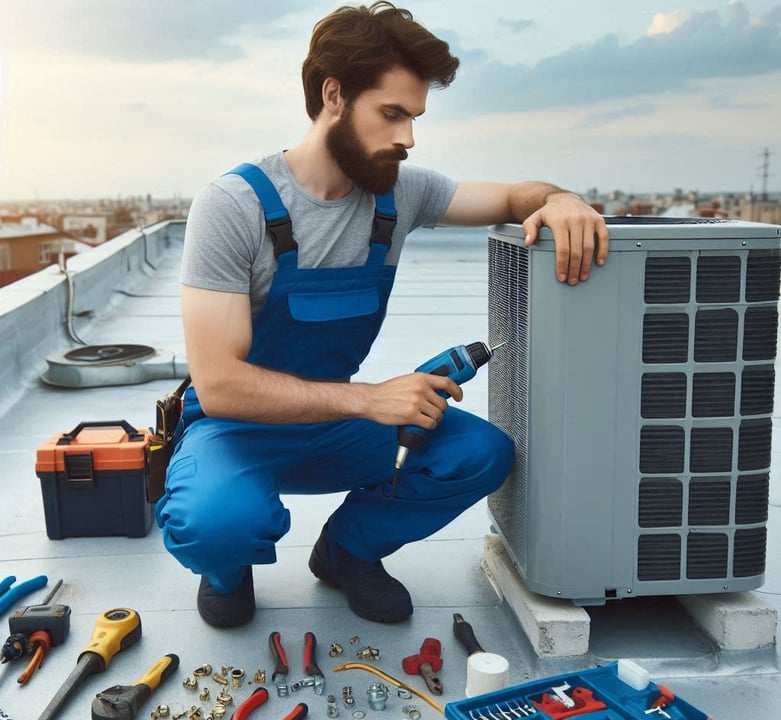Types of Air Conditioners.
6/29/20244 min read


Types of Air Conditioners.
Air conditioning (AC) systems are essential for maintaining comfort in homes, offices, and other indoor spaces, especially during hot weather. With various types of air conditioners available in the market, choosing the right one can be challenging. Each type has unique features, benefits, and drawbacks. This article provides an overview of the most common types of air conditioners to help you make an informed decision.
1. Central Air Conditioners
Description
Central air conditioners are designed to cool entire homes or large spaces. They consist of an outdoor unit that houses the compressor and condenser, and an indoor unit connected to a network of ducts that distribute cool air throughout the building.
Benefits
Efficient Cooling: Central ACs provide consistent and even cooling throughout the entire space.
Quiet Operation: The indoor components are often located away from living areas, reducing noise levels.
Improved Air Quality: These systems often include filters that remove dust, allergens, and other pollutants from the air.
Drawbacks
High Installation Cost: Installing a central air conditioner requires significant investment, including ductwork if it is not already present.
Maintenance: Regular maintenance is essential to ensure optimal performance and longevity.
2. Window Air Conditioners
Description
Window air conditioners are self-contained units that are installed in a window or through a hole in an exterior wall. They are typically used for cooling single rooms.
Benefits
Affordability: Window ACs are generally less expensive than central air systems and ductless mini-splits.
Ease of Installation: They are relatively easy to install and remove.
Space-Saving: These units do not take up floor space.
Drawbacks
Limited Cooling Capacity: Suitable only for small to medium-sized rooms.
Noise: Window AC units can be noisy, especially older models.
Aesthetic Impact: They can obstruct the view from the window and may not blend well with the exterior of the building.
3. Ductless Mini-Split Air Conditioners
Description
Ductless mini-split systems consist of an outdoor compressor unit and one or more indoor air-handling units. They do not require ductwork and are connected by a conduit that houses the power cable, refrigerant tubing, and condensate drain.
Benefits
Flexibility: Can be used to cool individual rooms or zones, allowing for customizable temperature control.
Energy Efficiency: Often more efficient than central air systems due to the absence of duct losses.
Quiet Operation: Indoor units operate quietly.
Drawbacks
Cost: Initial installation can be expensive, especially for multi-zone systems.
Aesthetic Considerations: Indoor units are mounted on walls and may not suit all interior designs.
4. Portable Air Conditioners
Description
Portable air conditioners are standalone units that can be moved from room to room. They typically require a nearby window to vent the exhaust air.
Benefits
Portability: Easily moved and set up in different rooms as needed.
No Permanent Installation: Ideal for renters or those who do not want to make permanent modifications to their space.
Drawbacks
Limited Cooling Capacity: Best suited for small rooms or specific areas.
Noise: Portable units can be noisy.
Ventilation Requirement: Need a window or another way to vent the exhaust air.
5. Hybrid Air Conditioners
Description
Hybrid air conditioners combine the functionality of air conditioning with another energy source, such as a heat pump, to provide both heating and cooling. They switch between the two modes based on the outdoor temperature.
Benefits
Energy Efficiency: Can be more energy-efficient than traditional AC systems, especially in moderate climates.
Versatility: Provide both heating and cooling, eliminating the need for separate systems.
Drawbacks
Complexity: More complex systems can mean higher initial costs and maintenance requirements.
Performance: Effectiveness can vary based on climate and specific installation.
6. Geothermal Air Conditioners
Description
Geothermal air conditioners, also known as ground-source heat pumps, utilize the stable temperatures of the ground to provide efficient cooling and heating. They consist of an underground loop system that exchanges heat with the earth.
Benefits
High Efficiency: Extremely energy-efficient, leading to lower operating costs.
Environmental Impact: Reduced carbon footprint compared to traditional systems.
Drawbacks
High Initial Cost: Installation is expensive due to the need for extensive ground loop systems.
Installation Requirements: Requires sufficient land area for the underground loops.
Conclusion
Choosing the right type of air conditioner depends on various factors, including the size of the space, budget, energy efficiency, and specific cooling needs. Central air conditioners are ideal for whole-house cooling, while window and portable units are suitable for individual rooms. Ductless mini-splits offer flexibility and efficiency for targeted cooling, whereas hybrid and geothermal systems provide energy-efficient alternatives with higher initial costs. Understanding the pros and cons of each type will help you select the most appropriate air conditioning solution for your home or office.
CONTACTS
9810330319
Support@kuwalacrepairservice

ADDRESS
E-24, PunchMukhi Mandir Lal Kuan, M.B Road, New Delhi - 110044
